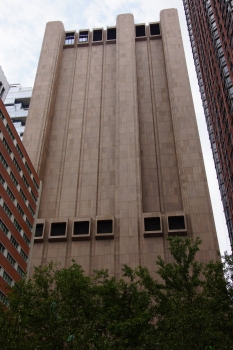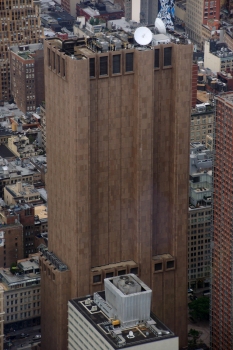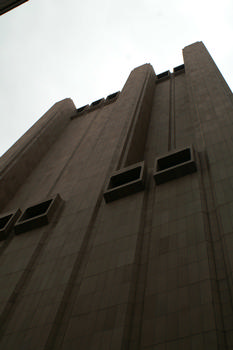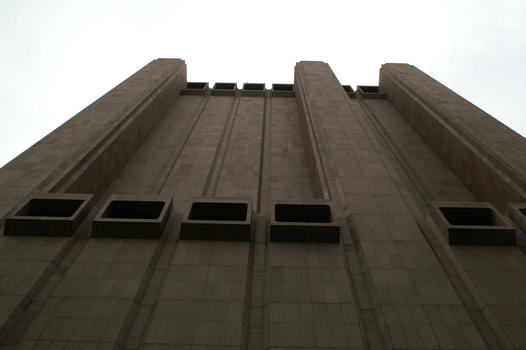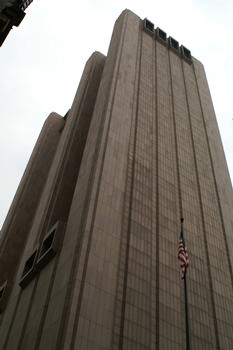General Information
| Other name(s): | 33 Thomas Street |
|---|---|
| Completion: | 1974 |
| Status: | in use |
Project Type
| Function / usage: |
Telephone exchange building |
|---|---|
| Architectural style: |
Brutalist |
Location
| Location: |
Manhattan, New York, New York, USA |
|---|---|
| Address: | 33 Thomas Street |
| Coordinates: | 40° 42' 59.30" N 74° 0' 21.18" W |
Technical Information
Dimensions
| height | 168 m | |
| number of floors (above ground) | 29 |
Notes
The building has virtually no windows in order to protect the equipment inside.
Excerpt from Wikipedia
33 Thomas Street (formerly the AT&T Long Lines Building) is a 550-foot-tall (170 m) skyscraper in Civic Center, Manhattan, New York City. It stands on the east side of Church Street, between Thomas Street and Worth Street. The building is an example of the Brutalist architectural style.
The building is a telephone exchange or wire center building which contained three major 4ESS switches used for interexchange (long distance) telephony, two owned by AT&T and one formerly owned by Verizon (decommissioned in 2009). It also contains a number of other switches used for competitive local exchange carrier (CLEC) services, but is not used for incumbent local exchange carrier (ILEC) services, and is not a central office. The CLLI code for this facility is NYCMNYBW. The building is reportedly home to a National Security Agency surveillance facility.
Design
The Long Lines Building was designed by architect John Carl Warnecke and completed in 1974. As it was built to house telephone switching equipment, the average floor height is 18 feet (5.5 meters), considerably taller than in an average high-rise. The floors are also unusually strong, designed to carry 200 to 300 pound per square foot (10–15 kPa) live loads.
The exterior walls are precast concrete panels clad with flame-treated textured Swedish granite faces. There are six large protrusions from the rectangular base which house air ducts, stairs and elevators. There is a series of large, protruding ventilation openings on the 10th and 29th floors. William H. Whyte claimed that it features the tallest blank wall in the world.
It is often described as one of the most secure buildings in America, and was designed to be self-sufficient with its own gas and water supplies along with generation capabilities and protected from nuclear fallout for up to two weeks after a nuclear blast. Its style has been generally praised, with The New York Times saying it is a rare building of its type in Manhattan that "makes sense architecturally" and that it "blends into its surroundings more gracefully" than any other skyscraper nearby.
History
The location was previously the site of cast-iron buildings, typical of the area, the facades of which were preserved prior to demolition. The building was a core part of the AT&T Long Lines Department, housing solid-state switching equipment which required a high level of security and space. The Long Lines Department became AT&T Communications in 1984, after the Bell System divestiture. The AT&T Long Lines Building is now commonly known by its street address, 33 Thomas St., like many major New York City commercial buildings.
AT&T gradually transitioned switches and other facilities from their former AT&T Long Lines headquarters building at 32 Sixth Avenue, just a few blocks away, completing the move by 1999. 33 Thomas is still used for telephone switching, but some of the space is also used as highly secure datacenter space.
On September 17, 1991, management failure, power equipment failure, and human error combined to completely disable AT&T's central office switch at 33 Thomas. As a result, over 5 million calls were blocked, and Federal Aviation Administration private lines were also interrupted, disrupting air traffic control to 398 airports serving most of the northeastern United States. Because the building was designed to be self-sufficient, AT&T had a load shedding agreement with the electric utility, Consolidated Edison, where they would voluntarily switch from utility power to on-site generators on request. This was a routine procedure that had been performed successfully in the past, but on this occasion, it went wrong. After switching power sources, standard procedure was to check all the equipment power supplies, known as DC plants, for problems. But due to scheduled training, the check was not performed, and one plant went on battery backup. The alarms were not detected until it was too late to maintain uninterrupted power.
After the destruction of the World Trade Center in the September 11, 2001 attacks, AT&T Local Services restored lost facilities they acquired from the former Teleport Communications Group based there, to 33 Thomas and 811 10th Avenue.
33 Thomas was described as the likely location of an NSA mass surveillance hub codenamed TITANPOINTE in an investigation by The Intercept, and in a documentary short film by Henrik Moltke and Laura Poitras titled Project X, both drawing on the surveillance disclosures of Edward Snowden. The investigation ties the facility to a nearby FBI building, and its rooftop equipment to NSA's "SKIDROWE" satellite intelligence system.
Text imported from Wikipedia article "33 Thomas Street" and modified on July 23, 2019 according to the CC-BY-SA 4.0 International license.
Participants
-
Warnecke Associates
- John Carl Warnecke (architect)
Relevant Web Sites
- About this
data sheet - Structure-ID
20012497 - Published on:
19/07/2004 - Last updated on:
07/10/2016


